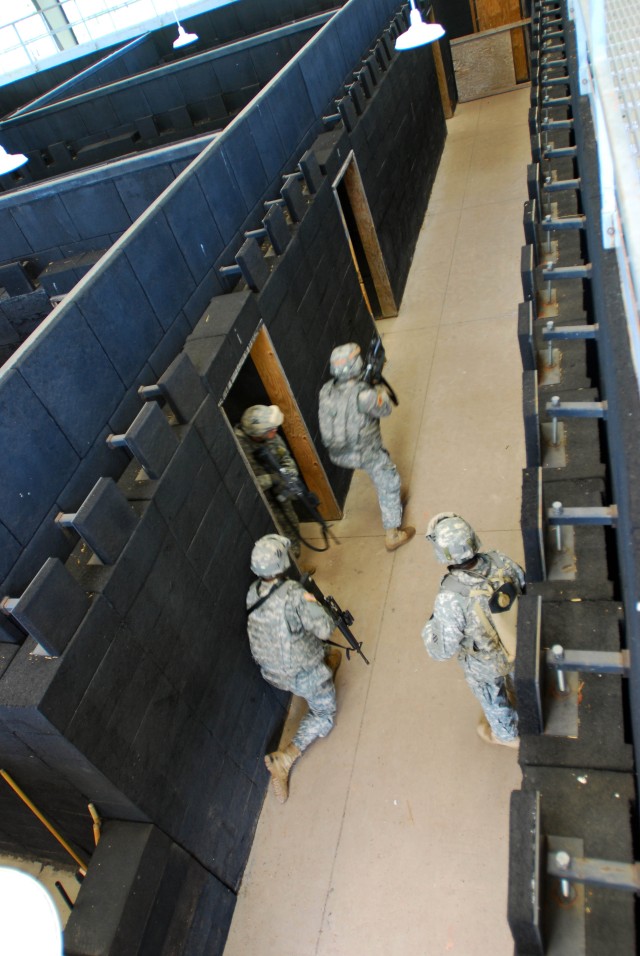<B> FORT STEWART, Ga. </B>- The four Soldiers stacked themselves against the door in the hallway and waited. An almost indiscernible movement was made between the Soldiers then instantly they sprang to life. One Soldier kicked down a door and returned to monitor the hallway while the other three quickly entered, firing shots at enemy targets.
"All clear," yelled the team leader. "Coming out!"
The Soldiers exited the room and continued their way down the hallway.
It was a military operations on urban terrain live-fire exercise taking place at Fort Stewart, Aug. 26. The training was not for training special operations Soldiers or even for infantry. This was the culmination event for the Soldiers in Company E, 4th Battalion, 3rd Aviation Regiment.
"There are several reasons this training is important - first for basic mission readiness," said Sgt. William Alford, squad leader in E Co., 4/3 Avn. "Also, our mission for this platoon is acting as a downed aircraft recovery team. An aircraft can go down anywhere, and we've been training, getting ourselves prepared for this. So let's say we're in the middle of a city, if an aircraft goes down and we saw the person (who) did it, we can go get them."
For months the Soldiers have been preparing for their deployment to Afghanistan. Knowing the terrain and needs of the Army would be different in Afghanistan than it was in Iraq. Lieutenant Colonel Robert Ault, commander of 4/3 Avn., has stressed the importance of combat-focused training.
"When you go to combat you don't know what you will have to do," he said. "We don't want just anyone to lead our Soldiers. If he can't do it better than his Soldiers, he probably shouldn't be a leader. Once they are selected, we trust them to lead our Soldiers. You never know what we're going to have to do. There is always the potential that there are structures inside the perimeter. Don't want their first time (facing such obstacles) to be in combat."
Combat-focused training has come to incorporate more than sergeants-time training. Companies have tailored their physical fitness routine in the mornings in addition to integrating battle drills and exercises to prepare their bodies and minds for whatever may be expected of them during deployment. For the Soldiers of E Co., 4/3 Avn., their training included their primary tasks of fueling and maintaining equipment in addition to learning aspects of the aircraft such as how to turn off engines and fuel, how to properly get crew members out of aircraft, and how to set up a defensive perimeter around an aircraft. The live shoothouse was the culminating event for the Soldiers of E Co., 4/3 Avn., serving as both a final test and a reward for months of hard work.
"The training was two-fold... to develop defensive capabilities in urban environments and to build teams," said Capt. Joseph Pruitt, commander of E Co., 4/3 Avn. "They established (standard operating procedures) within the teams to ensure they were communicating the same way. After a year of preparation, the live-rounds validated their training. It's like a reward - they get to shoot live rounds because they proved they know what they're doing."
In addition to instructing Soldiers on how to behave in the event of a shootout, the training also developed unity within the group. As each member of the team learned their role, the team became more cohesive, said Sgt. Alford.
"This training also serves as a team builder," said Sgt. Alford. "We do this over and over and over again, so they know what they're doing. They are fast learners and there is constant improvement. We are developing our (tactical-technical procedures) and the Soldiers are becoming more fluid with each training exercise. Now they move like clockwork."
Squad and team leaders were given the opportunity to develop their leadership techniques and implement their own TTPs. Each team's communication style was unique to the Soldiers within the team, allowing them to take ownership of and become comfortable with the tasks required of them.
"As a team leader, I better learned my Soldiers, their capabilities, strengths and weaknesses," said Spc. Ian Jones, E Co., 4/3 Avn. "This improved the confidence level of all the Soldiers in the team and made the members of my team more confident that when I make a decision, it's the right one. You have to make decisions in a matter of seconds, and I have to think not only about what decision is best for my team but who on my team possesses the right skills to do it."
"We had to move as a team throughout the exercise," said Spc. Nicholas Niedbalski, E Co., 4/3 Avn. "It helped our squad tremendously. We worked as a team while in a stressful environment, and I learned how to work with other people efficiently. I learned how other people react to situations and how to help people overcome their situations. I also learned what capabilities I have."
Having junior enlisted Soldiers thinking about their responsibilities as leaders is part of the goals Lt. Col. Ault set forth when preparing his battalion for deployment.
"People come into the Army to be sergeants, to lead Soldiers," said Lt. Col. Ault. "When they do (high-intensity training), they have to lead by example. We are selecting the right Soldiers to be sergeants, the right sergeants to be in key positions and then we train, train, train them. At the base, that's what all this is about."






Social Sharing